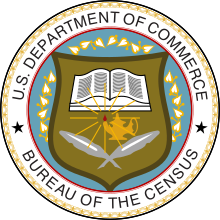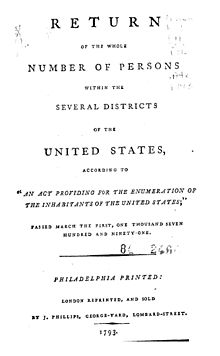1790 United States census
| 1790 United States census | ||
|---|---|---|
| ||
 Seal of the United States Census Bureau | ||
 Title page of 1790 United States census | ||
| General information | ||
| Country | United States | |
| Results | ||
| Total population | 3,929,214 | |
| Most populous | Virginia (747,610) | |
| Least populous | Delaware (59,094) | |
The United States census of 1790 was the first census of the whole United States. It recorded the population of the United States as of Census Day, August 2, 1790, as mandated by Article I, Section 2 of the United States Constitution and applicable laws. In the first census, the population of the United States was enumerated to be 3,929,214.[1][2]
Congress assigned responsibility for the 1790 census to the marshals of United States judicial districts under an act which, with minor modifications and extensions, governed census taking until the 1840 census. "The law required that every household be visited, that completed census schedules be posted in 'two of the most public places within [each jurisdiction], there to remain for the inspection of all concerned...' and that 'the aggregate amount of each description of persons' for every district be transmitted to the president."[3]
Contemporary perception
Both Secretary of State Thomas Jefferson and President George Washington expressed skepticism[4] over the results, believing that the true population had been undercounted. If there was indeed an undercount, possible explanations for it include dispersed population, poor transportation links, limitations of contemporary technology, and individual refusal to participate.[citation needed]
Loss of data
Although the census was proved statistically factual, based on data collected, the records for several states (including Delaware, Georgia, New Jersey, and Virginia) were lost sometime between 1790 and 1830.[5] Almost one third of the original census data have been lost or destroyed since their original documentation. These include some 1790 data from: Connecticut, Maine, Maryland, Massachusetts, New Hampshire, New York, North Carolina, Pennsylvania, Rhode Island, South Carolina, and Vermont; however, the validity and existence of most of these data can be confirmed in many secondary sources pertaining to the first census.[6]
Data availability
No microdata from the 1790 population census are available, but aggregate data for small areas, together with compatible cartographic boundary files, can be downloaded from the National Historical Geographic Information System.
Data
Census data included the name of the head of the family and categorized inhabitants as follows: free white males at least 16 years of age (to assess the country's industrial and military potential), free white males under 16 years of age, free white females, all other free persons (reported by sex and color), and slaves.[7] Under the direction of the Secretary of State Thomas Jefferson, marshals collected data from all thirteen states (Connecticut, Delaware, Georgia, Maryland, Massachusetts, New Hampshire, New Jersey, New York, North Carolina, Pennsylvania, Rhode Island, South Carolina, and Virginia), and from Maine and the Southwest Territory.[3] The census was not conducted in Vermont until 1791, after that state's admission to the Union as the 14th state on March 4 of that year. (From 1777 until early 1791, and hence during all of 1790, Vermont was a de facto independent country whose government took the position that Vermont was not then a part of the United States.)
At 17.8 percent, the 1790 census's proportion of slaves to the free population was the highest ever recorded by any census of the United States.[citation needed]
State or territory
|
Free white males of 16 years and upward[a]
|
Free white males under 16 years
|
Free white females[a]
|
All other free persons
|
Slaves
|
Slaves % of state population
|
Total
|
% of U.S. population
|
|---|---|---|---|---|---|---|---|---|
| Vermont | 22,435 | 22,328 | 40,505 | 255 | 16[b][8] | 0.0% | 85,539[c] | 2.2% |
| New Hampshire | 36,086 | 34,851 | 70,160 | 630 | 158 | 0.1% | 141,885 | 3.6% |
| Maine | 24,384 | 24,748 | 46,870 | 538 | 0 | 0.0% | 96,540 | 2.4% |
| Massachusetts | 95,453 | 87,289 | 190,582 | 5,463 | 0 | 0.0% | 378,787 | 9.8% |
| Rhode Island | 16,019 | 15,799 | 32,652 | 3,407 | 948 | 1.4% | 68,825 | 1.7% |
| Connecticut | 60,523 | 54,403 | 117,448 | 2,808 | 2,764 | 1.2% | 237,946 | 6.0% |
| New York | 83,700 | 78,122 | 152,320 | 4,654 | 21,324 | 6.3% | 340,120 | 8.6% |
| New Jersey | 45,251 | 41,416 | 83,287 | 2,762 | 11,423 | 6.2% | 184,139 | 4.6% |
| Pennsylvania | 110,788 | 106,948 | 206,363 | 6,537 | 3,737 | 0.9% | 434,373 | 11.0% |
| Delaware | 11,783 | 12,143 | 22,384 | 3,899 | 8,887 | 15.0% | 59,094[d] | 1.5% |
| Maryland | 55,915 | 51,339 | 101,395 | 8,043 | 103,036 | 32.2% | 319,728 | 8.1% |
| Virginia | 110,936 | 116,135 | 215,046 | 12,866 | 292,627 | 39.1% | 747,610[e][9] | 18.9% |
| Kentucky | 15,154 | 17,057 | 28,922 | 114 | 12,430 | 16.9% | 73,677 | 1.9% |
| North Carolina | 69,988 | 77,506 | 140,710 | 4,975 | 100,572 | 25.5% | 393,751 | 9.9% |
| South Carolina | 35,576 | 37,722 | 66,880 | 1,801 | 107,094 | 43.0% | 249,073 | 6.3% |
| Georgia | 13,103 | 14,044 | 25,739 | 398 | 29,264 | 35.5% | 82,548 | 2.1% |
| Southwest Territory | 6,271 | 10,277 | 15,365 | 361 | 3,417 | 9.6% | 35,691 | 0.9% |
| Total | 813,365 | 802,127 | 1,556,628 | 59,511 | 697,697 | 17.8% | 3,929,326 | 100% |
- ^ a b Heads of families were included.
- ^ The census of 1790, published in 1791, reports 16 enslaved persons in Vermont. Subsequently, and up to 1860, the number is given as 17. An examination of the original manuscript allegedly shows that there never were any slaves in Vermont. The original error occurred in preparing the results for publication, when 16 persons, returned as "Free colored", were classified as "Slave". But this claim is disputed by at least one historian.
- ^ Corrected figures are 85,425, or 114 less than figures published in 1790, due to an error of addition of several towns.
- ^ Corrected figures are 59,096, or 2 more than figures published in 1790, due to error in addition.
- ^ The figures for Virginia do not include the population of Kentucky. Though Kentucky was then a part of Virginia, the Kentucky figures were compiled separately, and are shown on the line for Kentucky. The Virginia figures do include the portion of Virginia that later became the state of West Virginia.
City rankings

References
- ^ "History: 1790 Fast Facts". U.S. Census Bureau.
- ^ Heads of Families at the First Census of the United States Taken Taken in the Year 1790. Department of Commerce and Labor, Bureau of the Census (publisher). Government Printing Office (printed 1908). 1908 [1790]. LCCN 07-35273; OCLC 2080540 (all editions); census.gov.
- "Connecticut" – via Google Books (University of California).
- "Maine" – via Google Books (University of Michigan).
- "Maryland" – via Google Books (University of California).
- "Massachusetts" – via Google Books (University of California).
- "New Hampshire" – via Google Books (NYPL).
- "New York" – via Google Books (Stanford).
- "New York" – via Internet Archive (Cornell).
- "North Carolina" – via Google Books (Stanford).
- "Pennsylvania" – via Google Books (University of California).
- "Rhode Island" – via Google Books (University of Michigan).
- "Vermont" – via Google Books (University of Virginia).
- "Virginia" – via Google Books (University of Michigan).
- ^ a b "History: 1790 Overview". U.S. Census Bureau.
- ^ "1790 Overview". U.S. Census Bureau.
- ^ Dollarhide, William (2001). The Census Book: A Genealogists Guide to Federal Census Facts, Schedules and Indexes. North Salt Lake, Utah: HeritageQuest. p. 7.
- ^ "1790 Census". 1930 Census Resources for Genealogists.
- ^ "1790 Census: Heads of Families". U.S. Census Bureau.
- ^ "Slavery in Vermont".
- ^ Census Office, United States (1909). "A Century of Population Growth from the First Census of the United States to the Twelfth, 1790–1900". p. 47.
- ^ Population of the 100 Largest Cities and Other Urban Places in the United States: 1790 to 1990, U.S. Census Bureau, 1998
- ^ "Population of Connecticut Towns 1756–1820". Connecticut Secretary of the State. State of Connecticut. Archived from the original on January 13, 2017. Retrieved April 13, 2020.
- ^ "Regions and Divisions". U.S. Census Bureau. Archived from the original on December 3, 2016. Retrieved September 9, 2016.
External links
![]() Media related to 1790 United States Census at Wikimedia Commons
Media related to 1790 United States Census at Wikimedia Commons
